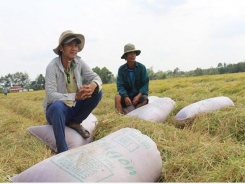Rice industry needs long term strategy

Amid the context of poor consumption, paddy price in Mekong Delta provinces is unlikely to be as high as it was in the past year; reducing rice farming area and balancing export volume are considered as a sustainable way out for the rice industry.
Traders buy paddy in the Mekong Delta provinces. (Photo: SGGP)
After the Prime Minister’s instruction to buy paddy for temporary storage, the prices of paddy slightly increased but remained lower than previous year. Paddy prices and consumption are still facing difficulties. Consumption of winter-spring paddy has become an urgent matter as firms do not have enough credit to buy paddy for farmers. In order to solve the problem, the Government should have solutions and policies to establish longer value chain for rice industry, said Mr. Le Minh Hoan, Secretary of Dong Thap Province’s Party Committee.
Firms have been increasing purchase of paddy for farmers in the past few days.
Mr. Nam Hung, a farmer in Chau Thanh A District in Hau Giang Province, said that although firms have started to buy paddy, prices are still at extremely low levels. He has just sold at VND4,600 per kilogram, VND1,000 per kilogram lower than that in the same period last year, though his paddy variety is of high quality.
At such price level, farmers merely earn a profit of around VND20 million per hectare, about VND10 million per hectare lower than that in the previous year. Currently, the prices of paddy in Hau Giang, Can Tho and An Giang fluctuate from VND4,600 to VND5,100 per kilogram.
The price of winter-spring paddy has dropped VND300 per kilogram compared to that in the period before lunar New Year and VND1,000 per kilogram compared to the same period last year. Farmers still have profits but not much. Banks should provide open mechanism for firms to access capital source. Relevant ministries and industries should allocate quotas for buying of paddy for temporary stockpile in order to stabilize paddy level in provinces in the Mekong Delta, Mr. Le Tien Chau, chairman of the People’s Committee of Hau Giang Province, suggested.
Paddy prices have slightly gone up by VND100-VND150 per kilogram in the last few days after the Prime Minister instructed firms to buy paddy for temporary stockpile. However, in rural and remote areas, it was difficult for farmers to sell paddy to traders. Amid the situation, Dong Thap, Hau Giang, Tien Giang and Long An provinces have encouraged cooperatives and firms to open their warehouses to help farmers to keep paddy until paddy prices rebound. At the present, most rice exporters have been experiencing financial crunch. Meanwhile, farmers are on pins and needles, waiting for the price to go up and firms to buy paddy.
Capital source, longer loan duration and interest rate are the three main issues mentioned by rice exporters. According to some firms, in recent years, export of rice has been smooth since the beginning of this year. Firms usually export rice immediately after they buy. However, consumption is poor this year so firms need longer loan duration to stockpile rice and wait for suitable time for export.
Mr. Nguyen Ngoc Nam, chairman of the Vietnam Food Association (VFA), said that rice export will be more complicated and face cutthroat competition this year.
Due to peak harvest, a sudden increase is seen in demand for stockpiling paddy. Most food traders experience a shortage of capital. VFA has proposed the State Bank of Vietnam (SBV) to ask commercial banks to provide specific credit package with maximum loan duration of six months to help firms to have enough money to buy paddy for farmers in March and hold initiative in choosing the suitable time to sell paddy. Hereby, farmers will also have money to invest in the coming summer-autumn rice crop.
SVB’s governor Le Minh Hung said that banks pledged to collaborate with provincial ministries and authorities to timely provide enough capital for firms with interest rate not higher than 6 percent per annum.
Mr. Le Minh Hoan said that the authority should get rid of old thinking and have a long-term strategy for rice industry though it does not contribute much in export turnover, it is the livelihood of millions farmers in the Mekong Delta provinces. His idea has received concurrence of several leaders of provinces in the Mekong Delta and firms.
Minister Nguyen Xuan Cuong of the Ministry of Agriculture and Rural Development said that the ministry is reviewing the area of paddy fields for the summary of food security program. In which, the ministry will propose a reduction of around 5,000 hectares of rice growing area out of 4 million hectares in inefficient regions. At the same time, it will carry out restructuring for rice industry. Firms will invest heavily in processing stage so as to make use of products made from rice, diversify market and focus on competing in home ground.
According to the Ministry of Agriculture and Rural Development, in the past 10 years, paddy production hit 700-709 million tons of which commercial rice was 31-48 million tons per annum. The largest rice producers in the world include China, India, Indonesia, Vietnam, Thailand, Myanmar, Brazil and Japan. Last year, rice exports exceeded US$3 billion, the highest level in the past six years.
Related news
Tools

Phối trộn thức ăn chăn nuôi

Pha dung dịch thủy canh

Định mức cho tôm ăn

Phối trộn phân bón NPK

Xác định tỷ lệ tôm sống

Chuyển đổi đơn vị phân bón

Xác định công suất sục khí

Chuyển đổi đơn vị tôm

Tính diện tích nhà kính

Tính thể tích ao



 Bình Phước pepper prices down, spelling struggles for…
Bình Phước pepper prices down, spelling struggles for…  Life hard for local pepper farmers
Life hard for local pepper farmers